Thermal Stability and High-Temperature Super Low Friction of γ-Fe2O3@SiO2 Nanocomposite Coatings on Steel
Abstract
:1. Introduction
2. Experimental Details
3. Results and Discussion
3.1. Microstructure of Coatings
3.2. Thermal Stability Analysis of Nanocomposite Coatings
3.3. High-Temperature Tribological Properties of Nanocomposite Coatings
4. Conclusions
- (1)
- Amorphous SiO2 in coatings is coated with crystal particles of γ-Fe2O3 due to the core–shell structures found by TEM. The microstructure of coatings can improve the thermal stability of γ-Fe2O3, and the temperature of the phase transition in γ-Fe2O3 can be increased from 460 to 829 °C according to the results of TG/DSC thermal analysis.
- (2)
- At 500 °C, the γ-Fe2O3@SiO2 nanocomposite coating can reach a stable super low friction coefficient of 0.05. The CoF of Ag coatings is about 0.05. The run-in time of nanocomposite coatings can be reduced with the doping of Ag. The CoF achieved by the γ-Fe2O3@SiO2-Ag-CeO2 nanocomposite coating is 0.06.
- (3)
- The volume wear rates of the γ-Fe2O3@SiO2 nanocomposite coatings, γ-Fe2O3@SiO2-Ag nanocomposite coatings and γ-Fe2O3@SiO2-Ag-CeO2 nanocomposite coatings are about 15.02 × 10−5 mm3 (Nm)−1, 4.32 × 10−5 mm3 (Nm)−1 and 8.65 × 10−5 mm3 (Nm)−1.
- (4)
- The high-temperature self-lubrication mechanism of coatings is attributed to the high-temperature soft phase of γ-Fe2O3 with low shear strength and the stability of Ag and CeO2 doping.
Funding
Data Availability Statement
Conflicts of Interest
References
- Dohda, K.; Boher, C.; Rezai-Aria, F.; Mahayotsanun, N. Tribology in metal forming at elevated temperatures. Friction 2015, 3, 1–27. [Google Scholar] [CrossRef]
- Zhu, S.; Cheng, J.; Qiao, Z.; Yang, J. High temperature solid-lubricating materials: A review. Tribol. Int. 2019, 133, 206–223. [Google Scholar] [CrossRef]
- Zeng, Q.; Zhang, W. A systematic review of the recent advances in superlubricity research. Coatings 2023, 13, 1989. [Google Scholar] [CrossRef]
- Zeng, Q. High-temperature superlubricity performance of h-BN coating on the textured inconel X750 alloy. Lubricants 2023, 11, 258. [Google Scholar] [CrossRef]
- Zeng, Q.; Qi, W. High temperature superlubricity behaviors achieved by AlSiN coatings against WS2 coatings at 600 °C. Ceram. Int. 2024, 50, 3787–3796. [Google Scholar] [CrossRef]
- Kumar, R.; Hussainova, I.; Rahmani, R.; Antonov, M. Solid lubrication at high-temperatures—A review. Materials 2022, 15, 1695. [Google Scholar] [CrossRef] [PubMed]
- Ouyang, J.; Li, Y.; Zhang, Y.; Wang, Y.; Wang, Y. High-temperature solid lubricants and self-lubricating composites: A critical review. Lubricants 2022, 10, 177. [Google Scholar] [CrossRef]
- Sarkar, M.; Mandal, N. Solid lubricant materials for high temperature application: A review. Mater. Today Proc. 2022, 66, 3762–3768. [Google Scholar] [CrossRef]
- Zeng, Q.; Eryilmaz, O.; Erdemir, A. Superlubricity of the DLC films-related friction system at elevated temperature. RSC Adv. 2015, 5, 93147–93154. [Google Scholar] [CrossRef]
- Zhu, J.; Zeng, Q.; He, W.; Yan, C.; He, W. Elevated-temperature super-lubrication performance analysis of dispersion-strengthened WSN coatings: Experimental research and first-principles calculation. Surf. Coat. Technol. 2021, 406, 126651. [Google Scholar] [CrossRef]
- Zeng, Q. High temperature low friction behavior of h-BN coatings against ZrO2. Coatings 2022, 12, 1772. [Google Scholar] [CrossRef]
- Rosenkranz, A.; Righi, M.; Sumant, A.; Anasori, B.; Mochalin, V. Perspectives of 2D MXene tribology. Adv. Mater. 2023, 35, 2207757. [Google Scholar] [CrossRef] [PubMed]
- Boidi, G.; F de Queiróz, J.C.; Profito, F.J.; Rosenkranz, A. Ti3C2Tx MXene manosheets as lubricant additives to lower friction under high loads, sliding ratios, and elevated temperatures. ACS Appl. Nano Mater. 2022, 6, 729–737. [Google Scholar] [CrossRef]
- Chhattal, M.; Kaihuan, Y.; Ali, S.; Zambrano, D.; Rosenkranz, A.; Grutzmacher, P.; Gong, Z.; Zhang, J. Solid lubrication performance of Ti2CTx coatings with reduced friction and extended durability. Tribol. Int. 2024, 194, 109535. [Google Scholar] [CrossRef]
- Cui, G.; Feng, X.; Han, W.; Liu, Y.; Kou, Z. Microstructure and high temperature wear behavior of in-situ synthesized carbides reinforced Mo-based coating by laser cladding. Surf. Coat. Technol. 2023, 467, 129713. [Google Scholar] [CrossRef]
- Gong, H.; Yu, C.; Zhang, L.; Xie, G.; Guo, D.; Luo, J. Intelligent lubricating materials: A review. Compos. Part B Eng. 2020, 202, 108450. [Google Scholar] [CrossRef]
- Jin, B.; Zhao, J.; Chen, G.; He, Y.; Huang, Y.; Luo, J. In situ synthesis of Mn3O4/graphene nanocomposite and its application as a lubrication additive at high temperatures. Appl. Surf. Sci. 2021, 546, 149019. [Google Scholar] [CrossRef]
- Cao, H.; Momand, J.; Syariati, A.; Wen, F.; Rudolf, P.; Xiao, P.; De Hosson, J.; Pei, Y. Temperature-adaptive ultralubricity of a WS2/a-C nanocomposite coating: Performance from room temperature up to 500 °C. ACS Appl. Mater. Interfaces 2021, 13, 28843–28854. [Google Scholar] [CrossRef]
- Zeng, Q.; Cai, S.; Li, S. High-temperature low-friction behaviors of γ-Fe2O3@SiO2 nanocomposite coatings obtained through sol–gel method. J. Sol-Gel Sci. Technol. 2018, 85, 558–566. [Google Scholar] [CrossRef]
- Bondarev, A.; Kvashnin, D.; Shchetinin, I.; Shtansky, D. Temperature-dependent structural transformation and friction behavior of nanocomposite VCN-(Ag) coatings. Mater. Des. 2018, 160, 964–973. [Google Scholar] [CrossRef]
- Zeng, Q.; Cai, S. Low-friction behaviors of Ag-doped γ-Fe2O3@SiO2 nanocomposite coatings under a wide range of temperature conditions. J. Sol-Gel Sci. Technol. 2019, 90, 271–280. [Google Scholar] [CrossRef]
- Wilhelmsson, O.; Råsander, M.; Carlsson, M.; Lewin, E.; Sanyal, B.; Wiklund, U.; Eriksson, O.; Jansson, U. Design of nanocomposite low-friction coatings. Adv. Funct. Mater. 2007, 17, 1611–1616. [Google Scholar] [CrossRef]
- Mallakpour, S.; Khadem, E. Carbon nanotube–metal oxide nanocomposites: Fabrication, properties and applications. Chem. Eng. J. 2016, 302, 344–367. [Google Scholar] [CrossRef]
- Okpala, C. Nanocomposites—An overview. Int. J. Eng. Res. Dev. 2013, 8, 17–23. [Google Scholar]
- Yin, L.; Pan, Y.; Li, M.; Zhao, Y.; Luo, S. Facile and scalable synthesis of α-Fe2O3/γ-Fe2O3/Fe/C nanocomposite as advanced anode materials for lithium/sodium ion batteries. Nanotechnology 2020, 31, 155402. [Google Scholar] [CrossRef] [PubMed]
- Yang, J.; Jiang, Y.; Hardell, J.; Fang, Q. Influence of service temperature on tribological characteristics of self-lubricant coatings: A review. Front. Mater. Sci. 2013, 7, 28–39. [Google Scholar] [CrossRef]
- Aouadi, S.; Paudel, Y.; Luster, B.; Stadler, S.; Kohli, P.; Muratore, C. Adaptive Mo2N/MoS2/Ag tribological nanocomposite coatings for aerospace applications. Tribol. Lett. 2008, 29, 95–103. [Google Scholar]
- Voevodin, A.; Zabinski, J. Nanocomposite and nanostructured tribological materials for space applications. Compos. Sci. Technol. 2005, 65, 741–748. [Google Scholar] [CrossRef]
- Voevodin, A.; O’neill, J.; Zabinski, J. Nanocomposite tribological coatings for aerospace applications. Surf. Coat. Technol. 1999, 116, 36–45. [Google Scholar] [CrossRef]
- Wang, X.; Gao, X.; Zhang, Z.; Cheng, L.; Ma, H.; Yang, W. Advances in modifications and high-temperature applications of silicon carbide ceramic matrix composites in aerospace: A focused review. J. Eur. Ceram. Soc. 2021, 41, 4671–4688. [Google Scholar] [CrossRef]
- Ji, Z.; Zhang, L.; Xie, G.; Xu, W.; Guo, D.; Luo, J.; Prakan, B. Mechanical and tribological properties of nanocomposites incorporated with two-dimensional materials. Friction 2020, 8, 813–846. [Google Scholar] [CrossRef]
- Su, Y.; Huang, W.; Cai, L.; Gong, X.; Zhang, T.; Hu, R.; Zhang, P.; Ruan, H. Microstructural evolution and tribology of Mo-doped diamond like carbon nanocomposite film. Tribol. Int. 2022, 174, 107774. [Google Scholar] [CrossRef]
- Ding, J.; Cheng, Y.; Zhang, S.; Wang, Q.; Zhang, T. Microstructure, mechanical and tribological properties of Ti doped ta-C films deposited by a hybrid coating system. Diam. Relat. Mater. 2023, 131, 109565. [Google Scholar] [CrossRef]
- Grenadyorov, A.; Solovyev, A.; Oskirko, V.; Oskomov, V.; Semenov, V.; Sypchenko, V.; Saraev, A. Structure, mechanical and tribological properties of Ti-doped and Cr-doped aC: H: SiOx coatings. Vacuum 2024, 219, 112706. [Google Scholar] [CrossRef]
- Xu, X.; Sun, J.; Su, F.; Li, Z.; Chen, Y.; Xu, Z. Microstructure and tribological performance of adaptive MoN–Ag nanocomposite coatings with various Ag contents. Wear 2022, 488, 204170. [Google Scholar] [CrossRef]
- Chen, Y.; Sun, J.; Liu, Y.; Li, Q.; Xiao, S.; Su, F. Microstructure, mechanical and high-temperature tribological properties of MoS2-Cr-Ag composite films. Surf. Coat. Technol. 2023, 452, 129135. [Google Scholar] [CrossRef]
- Dong, Y.; Wang, Z.; Yuan, J.; Wang, Z.; Zhang, Y.; Ma, G.; Wang, A. Temperature-adaptive lubrication of Ag doped Cr2AlC nanocomposite coatings. Wear 2024, 540, 205221. [Google Scholar] [CrossRef]
- Huang, K.; Cao, X.; Kong, L.; Lu, Z.; Ding, Q.; Hu, H. Effect of Ag content on friction and wear properties of Ag and V co-doped CrN coatings at 25–700 °C. Ceram. Int. 2021, 47, 35021–35028. [Google Scholar] [CrossRef]
- Patnaik, L.; Maity, S.R.; Kumar, S. Comprehensive structural, nanomechanical and tribological evaluation of silver doped DLC thin film coating with chromium interlayer (Ag-DLC/Cr) for biomedical application. Ceram. Int. 2020, 46, 22805–22818. [Google Scholar] [CrossRef]
- Wang, X.; Liu, S.; Zhang, M.; Qu, K. Effect of rare earth oxide on the microstructure and wear properties of in situ–synthesized ceramics-reinforced Fe-based laser cladding coatings. Tribol. Trans. 2020, 63, 345–355. [Google Scholar] [CrossRef]
- Gupta, P.; Ahamad, N.; Kumar, D.; Gupta, N.; Chaudhary, V.; Gupta, S.; Khanna, V.; Chaudhary, V. Synergetic effect of CeO2 doping on structural and tribological behavior of Fe-Al2O3 metal matrix nanocomposites. ECS J. Solid State Sci. Technol. 2022, 11, 117001. [Google Scholar] [CrossRef]
- Du, J.; Li, F.; Li, Y.; Lu, H.; Qi, X.; Yang, B.; Li, C.; Yu, P.; Cao, Y. High temperature oxidation behavior and interface diffusion of Cr3C2-NiCrCoMo/nano-CeO2 composite coatings. J. Alloys Compd. 2022, 905, 164177. [Google Scholar] [CrossRef]
- Du, J.; Li, F.; Li, Y.; Lu, H.; Qi, X.; Yang, B.; Li, C.; Yu, P.; Wang, J.; Gao, L. The influence of nano-CeO2 on tribological properties and microstructure evolution of Cr3C2-NiCrCoMo composite coatings at high temperature. Surf. Coat. Technol. 2021, 428, 127913. [Google Scholar] [CrossRef]
- Min, C.; He, Z.; Song, H.; Liu, D.; Jia, W.; Qian, J.; Yu, H.; Guo, L. Fabrication of novel CeO2/GO/CNTs ternary nanocomposites with enhanced tribological performance. Appl. Sci. 2019, 9, 170. [Google Scholar] [CrossRef]
- Kumar, S.; Kumar, D. Role of CeO2 doping on tribological behavior of Al2O3 coated AZ91 alloy. Surf. Coat. Technol. 2018, 349, 462–469. [Google Scholar] [CrossRef]
- Zhou, Y.; Zhang, Z.; Yue, Y. Synthesis and self-organization of γ-Fe2O3 nanoparticles by hydrothermal chemical vapor deposition. Mater. Lett. 2005, 59, 3375–3377. [Google Scholar] [CrossRef]
- Bi, Q.; Luo, X.; Guo, L.; Zuo, X.; Huang, B.; Yi, J.; Zhou, Y. Effects of in-situ reaction, extrusion ratio and CeO2 on the performance of Al-Ti-C-(Ce) grain refiners for refining pure aluminum grains. Materials 2023, 16, 4481. [Google Scholar] [CrossRef] [PubMed]
- You, S.; Xing, S.; Jiang, C. The influence of CeO2 particle with various sizes on the microstructure and properties of electrodeposited Ni-CeO2 composite coatings. Mater. Charact. 2023, 205, 113327. [Google Scholar] [CrossRef]
- Stagi, L.; De Toro, J.A.; Ardu, A.; Cannas, C.; Casu, A.; Lee, S.; Ricci, P. Surface effects under visible irradiation and heat treatment on the phase stability of γ-Fe2O3 nanoparticles and γ-Fe2O3−SiO2 core–shell nanostructures. J. Phys. Chem. C 2014, 118, 2857–2866. [Google Scholar]
- Yu, X.; Liu, S.; Yu, J. Superparamagnetic γ-Fe2O3@SiO2@TiO2 composite microspheres with superior photocatalytic properties. Appl. Catal. B Environ. 2011, 104, 12–20. [Google Scholar] [CrossRef]
- Guo, H.; Barnard, A.S. Modeling the iron oxides and oxyhydroxides for the prediction of environmentally sensitive phase transformations. Phys. Rev. B 2011, 83, 094112. [Google Scholar] [CrossRef]
- Monshi, A.; Foroughi, M.; Monshi, M. Modified Scherrer equation to estimate more accurately nano-crystallite size using XRD. World J. Nano Sci. Eng. 2012, 2, 154–160. [Google Scholar] [CrossRef]
- Fatimah, S.; Ragadhita, R.; Al Husaeni, D.; Nandiyanto, A. How to calculate crystallite size from X-ray diffraction (XRD) using Scherrer method. ASEAN J. Sci. Eng. 2022, 2, 65–76. [Google Scholar] [CrossRef]
- Rabiei, M.; Palevicius, A.; Monshi, A.; Nasiri, S.; Vilkauskas, A.; Janusas, G. Comparing methods for calculating nano crystal size of natural hydroxyapatite using X-ray diffraction. Nanomaterials 2020, 10, 1627. [Google Scholar] [CrossRef]


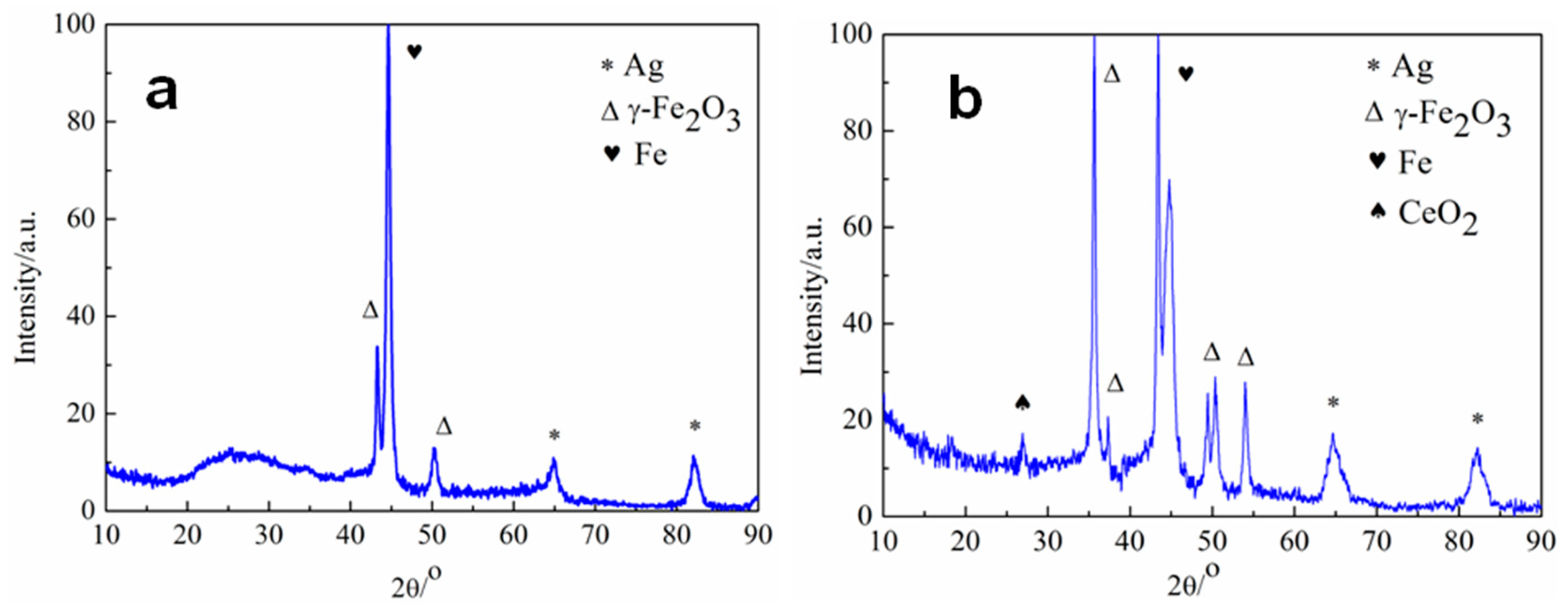
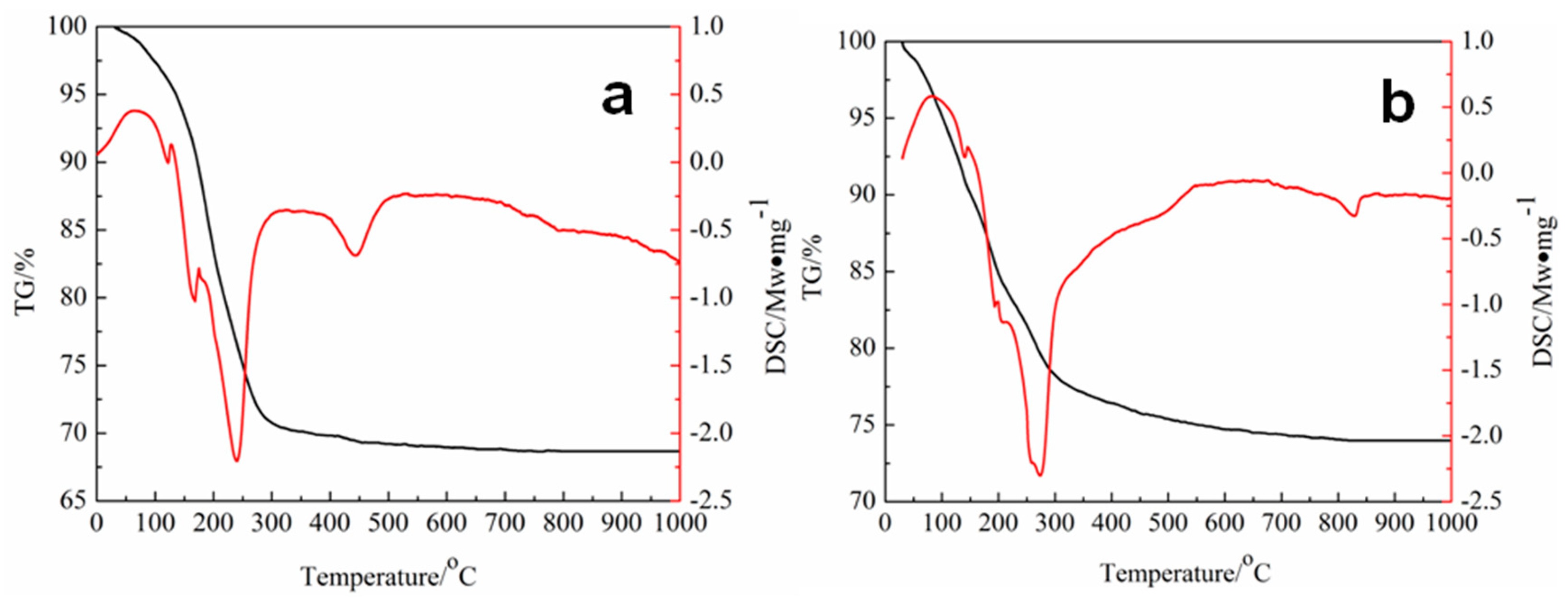
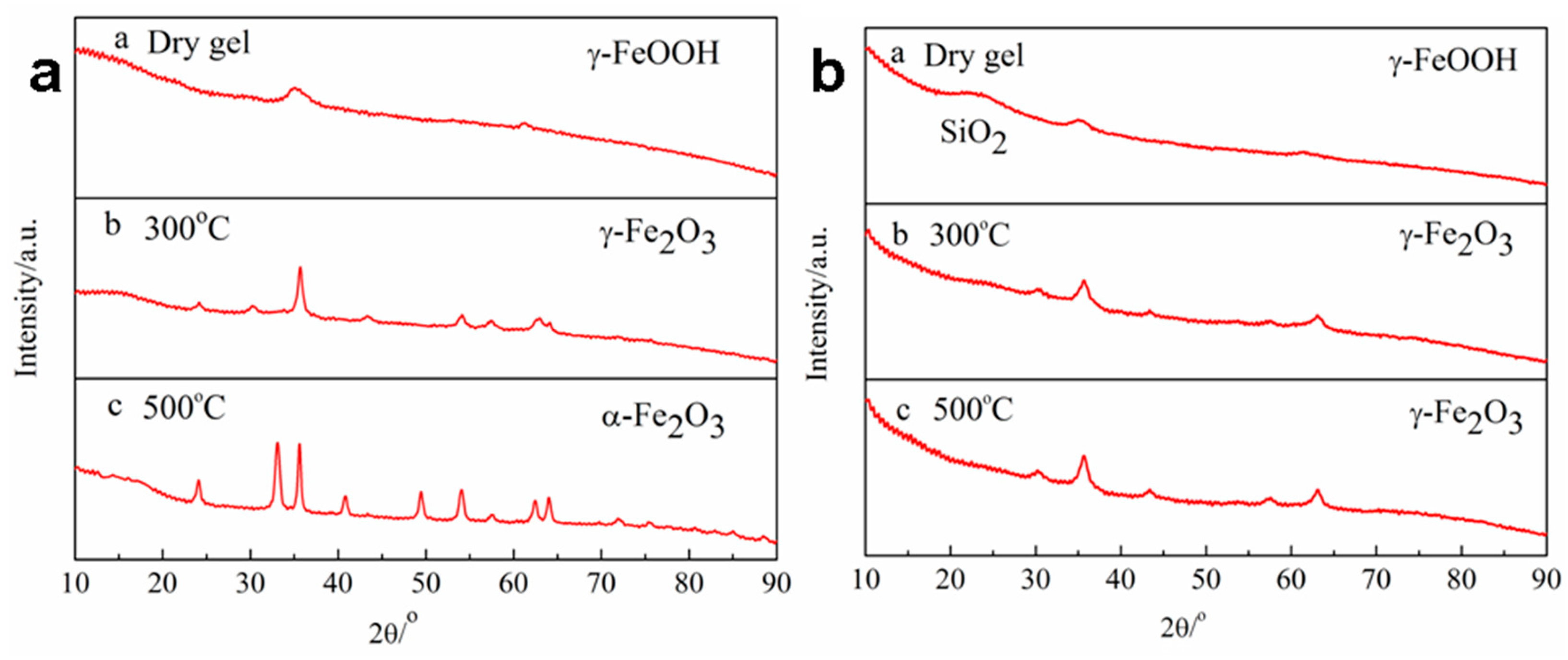


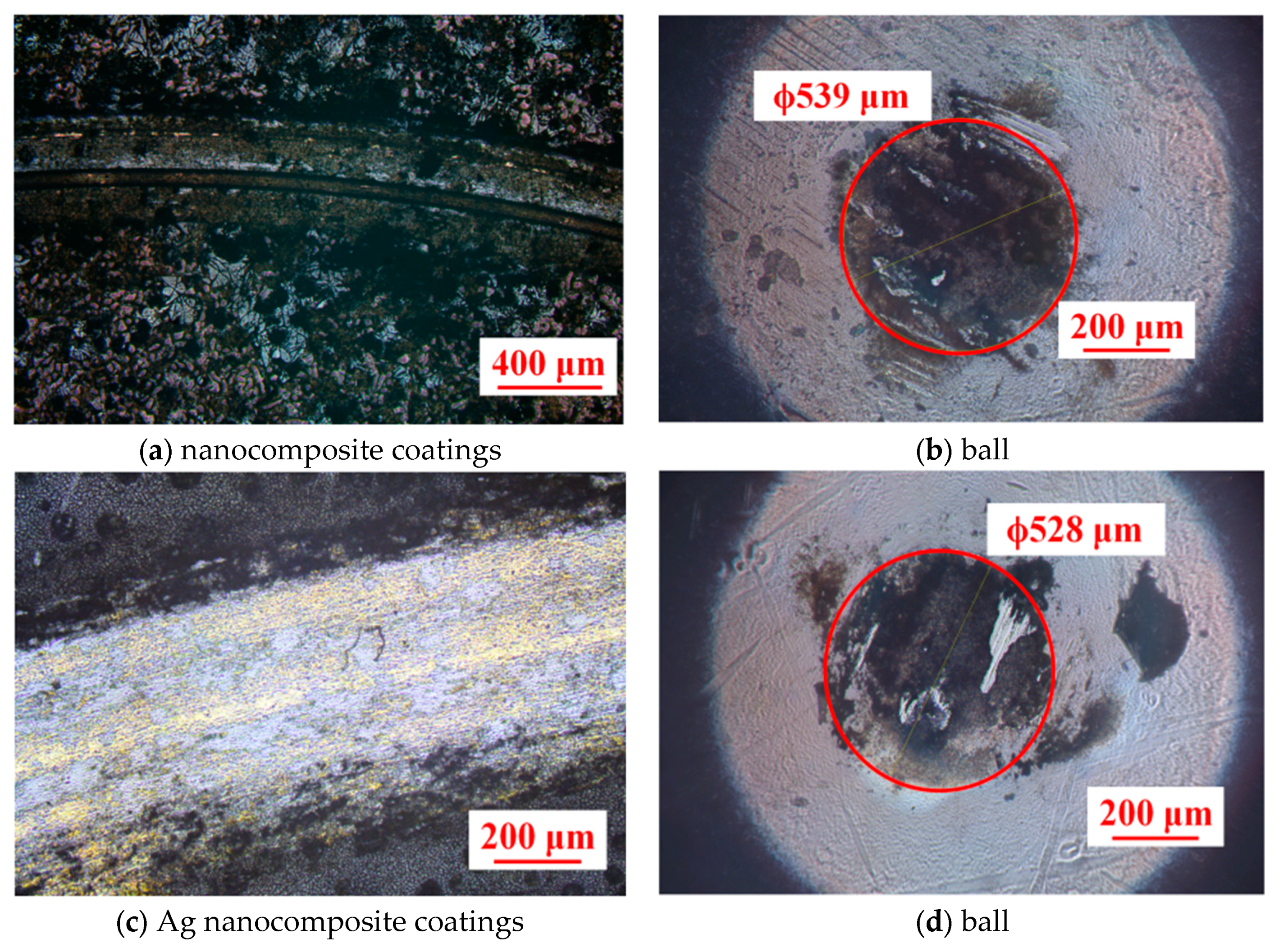
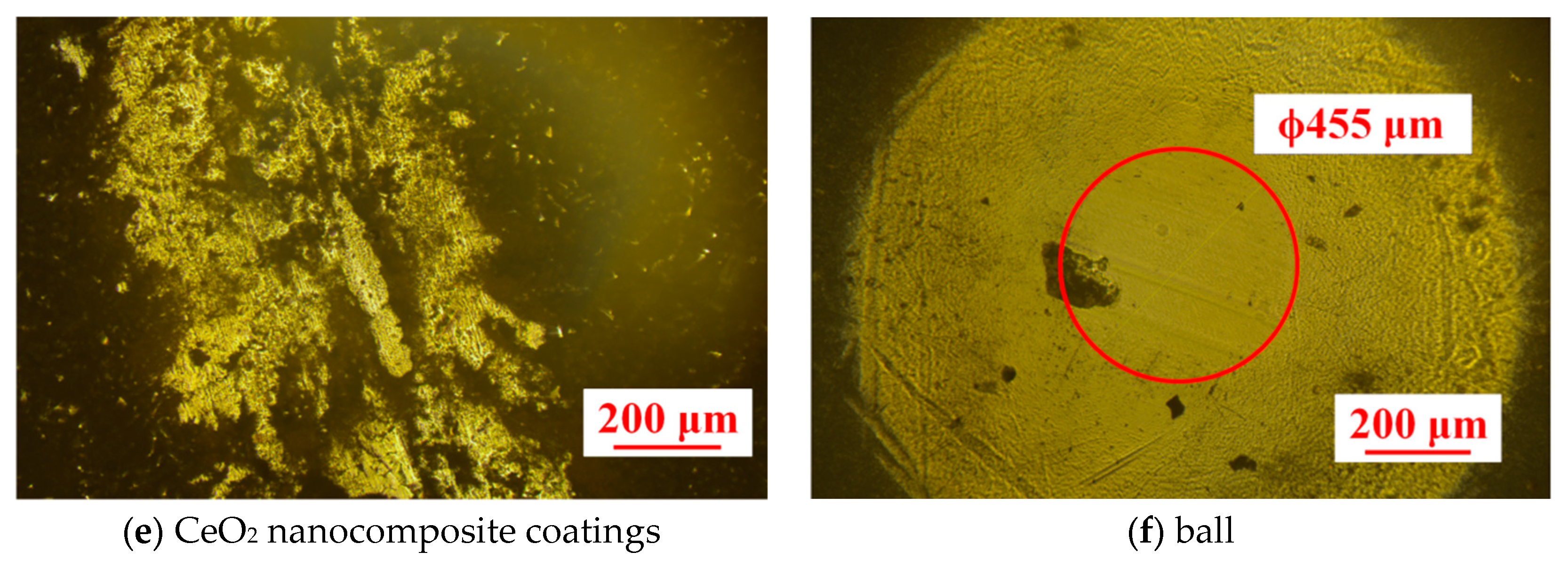
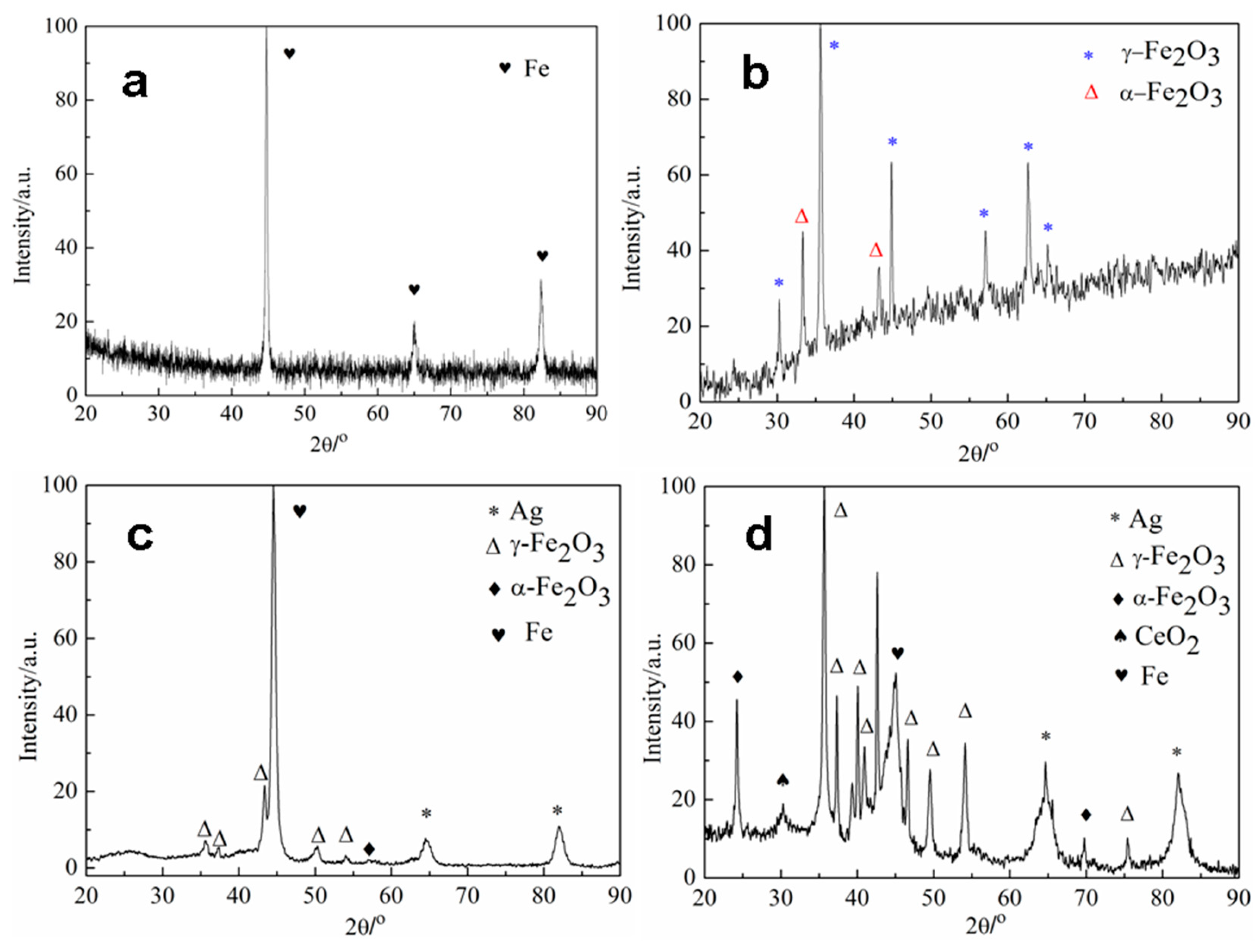
Disclaimer/Publisher’s Note: The statements, opinions and data contained in all publications are solely those of the individual author(s) and contributor(s) and not of MDPI and/or the editor(s). MDPI and/or the editor(s) disclaim responsibility for any injury to people or property resulting from any ideas, methods, instructions or products referred to in the content. |
© 2024 by the author. Licensee MDPI, Basel, Switzerland. This article is an open access article distributed under the terms and conditions of the Creative Commons Attribution (CC BY) license (https://creativecommons.org/licenses/by/4.0/).
Share and Cite
Zeng, Q. Thermal Stability and High-Temperature Super Low Friction of γ-Fe2O3@SiO2 Nanocomposite Coatings on Steel. Lubricants 2024, 12, 223. https://doi.org/10.3390/lubricants12060223
Zeng Q. Thermal Stability and High-Temperature Super Low Friction of γ-Fe2O3@SiO2 Nanocomposite Coatings on Steel. Lubricants. 2024; 12(6):223. https://doi.org/10.3390/lubricants12060223
Chicago/Turabian StyleZeng, Qunfeng. 2024. "Thermal Stability and High-Temperature Super Low Friction of γ-Fe2O3@SiO2 Nanocomposite Coatings on Steel" Lubricants 12, no. 6: 223. https://doi.org/10.3390/lubricants12060223
APA StyleZeng, Q. (2024). Thermal Stability and High-Temperature Super Low Friction of γ-Fe2O3@SiO2 Nanocomposite Coatings on Steel. Lubricants, 12(6), 223. https://doi.org/10.3390/lubricants12060223




